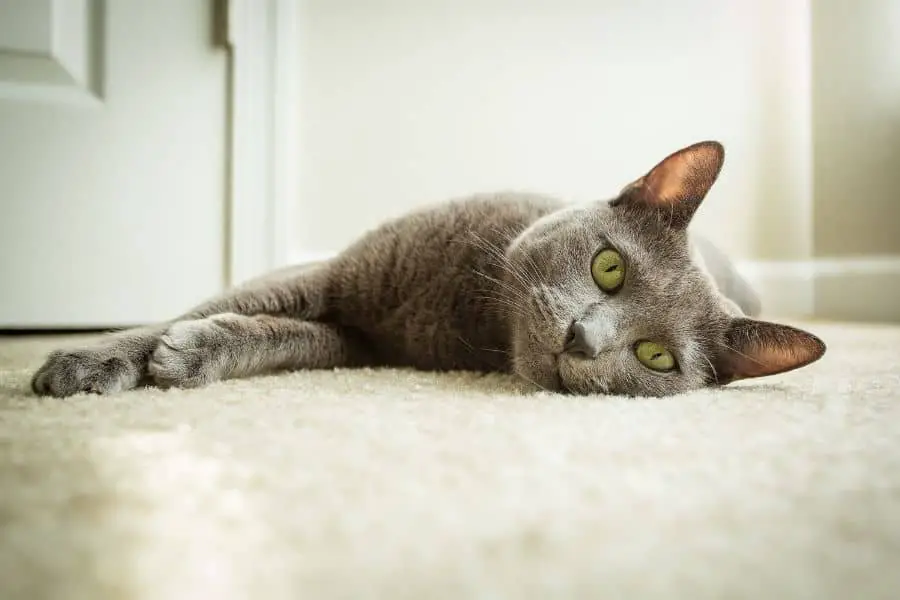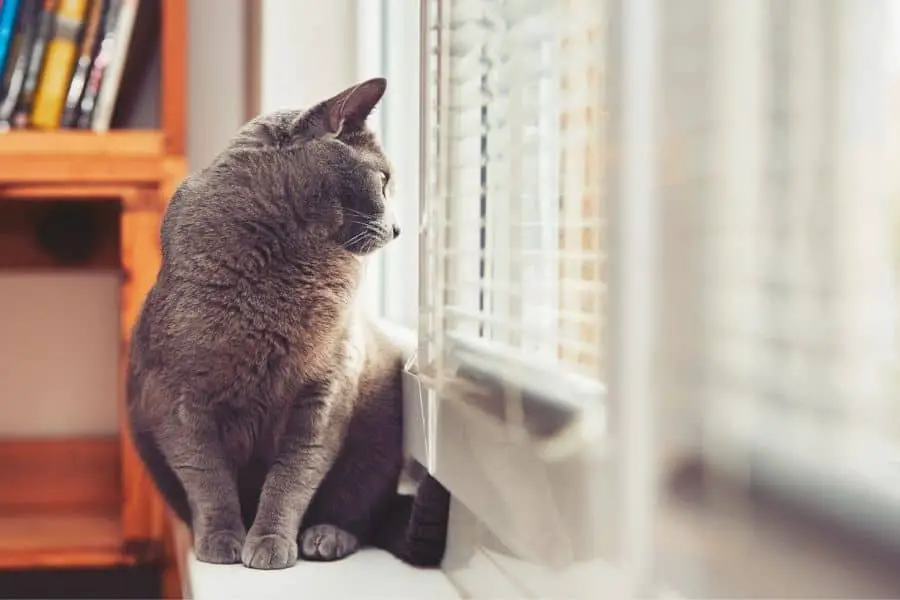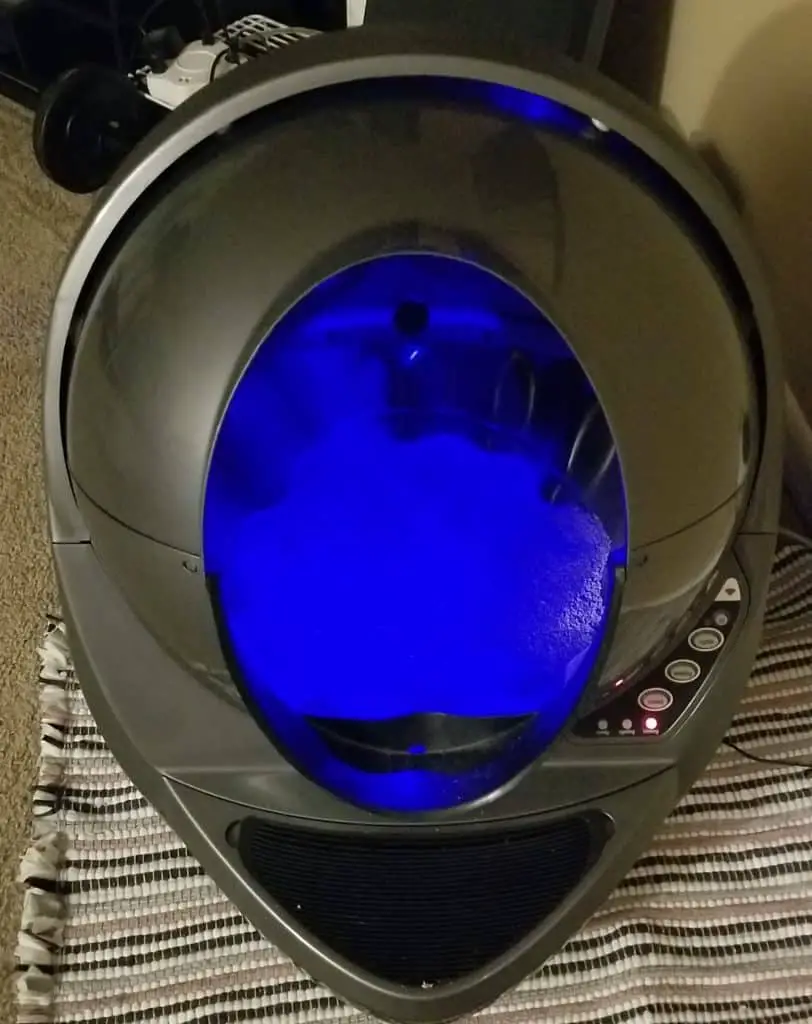More Meows is an Amazon Associate. As an Amazon Associate we earn from qualifying purchases. We may also earn commissions if you purchase products from other retailers after clicking on a link from our site.
As cat lovers, we all have our favorite breeds or color combinations, it’s true. Most of us would agree that, despite our personal favorites, the Russian Blue is a genuinely stunning feline worthy of our admiration and appreciation.
A real Russian Blue cat is notable for its silky, double coat of blue and silver fur and its large, round emerald green eyes. To be considered a true Blue, it must have registration documents showing its Russian Blue pedigree.
Suppose you see a gray-bluish cat wandering the neighborhood or available in the local pet store. Could you tell if it’s a Russian Blue? They’re relatively uncommon, so that’s not a likely scenario. Still, how would you know? Grab some catnip and keep reading.
Pro-Tip: If you are thinking of buying a cat or are a cat owner already, then you should be aware that taking care of the litter box can be a real chore. In this age of smart products, an automatic litter box has been created that actually makes life easier with taking care of the litter box. If you want to make your life much easier with a litter box that means you’ll never have to scoop litter again, check out the best automatic litter box on the market (in my opinion) on Amazon.
Russian Blue Pedigree

The Russian blue cat is a rare, naturally occurring breed with origins in northern Russia. Thought to be descended from the Russian czars’ cats, the Russian Blue made its way west to England and northern Europe in the 1860s.
The breed was known as the “Archangel” cat, most likely because it left Russia on ships sailing from the port of Arkhangelsk. Introduced by this name in 1875 at London’s Crystal Palace, the Russian Blue was cross-bred with Siamese and British Blues during World War II, giving rise to other fur colors.
So, even though this cross-breeding in the 1940s led to some black and white-furred Blues with similar physical characteristics, these are not considered real Russian Blues. There are many silvery gray cats out there, and many have some of the features we’ll discuss in this article. But, even though they may look similar, chances are these are not real Blues.
The only sure way to determine if your cat is a genuine Russian Blue is through its pedigree.
Cat Registration Organizations
Various cat organizations like Cat Fanciers Association (CFA) and TICA (The International Cat Association) take the breed’s purity very seriously. Russian Blues have been selectively bred for years, and these groups keep meticulous records of ancestry and pedigree.
For example, to register a Russian Blue with the CFA, an owner must present certified pedigrees showing eight generations of Russian Blue ancestry. Authentic Russian Blues are only registered in one color (blue) and one fur length (short). The result is a very distinct breed in appearance and personality.
In summary, a real Russian Blue has been registered and has the ancestry and papers to prove it.
Russian Blue Cat Characteristics
In addition to the pedigree prerequisite, to be considered a true Russian Blue, a cat must exhibit a particular set of characteristics in appearance and behavior. The absence of these traits indicates a compromised ancestry of cross-breeding.
The characteristics of Russian Blue cats are what makes them fantastic. Check out my article on the twelve reasons why Russian Blue cats are the best: Click Here.
Distinctive Fur
According to Purina, the Russian Blue’s coat “is the truest measure of the breed.” The Russian Blue gets its name from the distinct silvery-blue color of its fur. It’s one of the first things you notice about this beautiful feline.
- The underfur should be an even, bright blue color with no pattern on a mature cat. The breed standard suggests that lighter blues are preferred.
- Guard hairs, the protective top coat of fur, on a Russian Blue are tipped in a silvery color, which gives the cat an overall shimmery silver appearance.
Russian Blues are short-haired cats that shed very little. Their double coat of fur is thick and fine with a plush, silky feel. The density of the Blue’s fur causes the fur to stand out from the body, giving the cat an appearance of being heftier than it really is.
The thick coat of the Blue’s fur holds its shape when rubbed. In fact, the fur is so luxurious that you can draw designs in it with your fingers, and the design will stay there until you brush it away.
Features of the Head
The head of a real Russian Blue cat is triangular, of medium size, but with a broad face across the eye area. The top of the head is flat. The muzzle appears blunt in profile, and the nose goes straight down without an upturn at the end. The mouth is often described as having a natural, somewhat enigmatic “smile.”
Other notable features of the Russian Blue cat’s head include:
- Eyes – Large, round, wide-set eyes are renowned for their vivid emerald green color. A Russian Blue kitten’s eyes are yellow until it’s about four months old. At that age, a green ring appears around the pupil, and the eye gradually turns a memorable shade of green as the cat matures.
- Ears – Ears are another prominent feature of the Russian Blue breed. Compared to the medium size structure of the head overall, the ears are large with a broad base where they join the head and have pointed tips rather than round. Rather than sitting straight off the top of the head, a Blue’s ears are set slightly askew, more off the side of the head than the top, giving the cat a rakish appearance.
Body Type
The Russian Blue is a medium-sized cat overall, often described as fine-boned or slender. However, this description is a bit deceiving as the Blue’s body is actually long and lean, strong and muscular. With a thick coat of fur, the cat’s long, thin neck looks more significant than it really is. The male cat weighs around 10-12 pounds, while the female is slightly smaller at 7-10 pounds.
This tall cat carries itself with grace and agility on long, slender legs. One unique feature of its feet is the mauve or lavender-pink color of the paw pads. Russian Blues also have a long tail that is proportional to the rest of the body.

Personality
The Russian Blue cat is intelligent, sweet, and shy with an endearing air of elegant grace. This reserved temperament means that he is affectionate with those he knows but more aloof with strangers.
Like most cats, Blues like routine and dislike change. They are fairly sensitive and startle easily. Give them a loving, stable environment, and they are incredibly loyal, usually choosing one human to be “their human” even while getting along with everyone in the house.
The Blue is social and likes to play but will also find a cozy spot to curl up and nap. Fetching and swatting at feathery toys is a favorite pastime. Their keen intelligence requires you to engage and challenge them with toys and puzzles, and they are easily trained.
Russian Blues are playful cats and one of the toys that cats like to play with most is a floating butterfly. I recommend this floating butterfly toy on Amazon (affiliate link): Check Out This Floating Butterfly Toy On Amazon!
In fact, these felines like to sit back and observe what’s going on and can sometimes figure out how to open a door or get into the treat bag.
Russian Blue cats are gentle creatures that I personally would not send outside on their own. To learn more about Russian Blue cats and the outdoors, check out my article on if Russian Blue cats can go outside: Click Here.
Behavior
While not overly vocal, Russian Blues have a quiet voice when they do speak. They make their wishes known and can learn to recognize the meaning of words if you talk to them consistently.
As for personal hygiene, Blues are fastidious, often refusing to even go into a litter box if it’s not completely clean.
Cat’s like tall perches to sit on and observe everyone. Additionally, cats like to scratch their claws on scratching posts. A cat condo / cat tree is the best of both worlds since it combines tall platforms with scratching posts for the pillars on it. My cat, Charlotte (a domestic shorthair) loves her cat tree. I recommend this cat condo / cat tree from Amazon (affiliate link): Check Out This Awesome Cat Tree On Amazon!
Final Thoughts
Identifying a cat as a real Russian Blue is really very simple. Physical characteristics, as we’ve noted in this article, may lead you to believe a cat is a Russian Blue. You may be correct about that, but the only sure-fire way to prove it is with registration papers.
Authentic Russian Blues have the pedigree to back up their appearance. Without the papers to confirm lineage, that gray cat roaming the neighborhood is just a distant feline cousin to the regal Russian Blue.
If you enjoyed this article, please check out a couple of others:
- Do Cats Like Cat Strollers? (The Honest Truth): Click Here.
- Are Cats Popular In Russia? The Best Answers: Click Here.
- 9 Reasons For Russian Blue Cat Biting (Epic List): Click Here.
Here are some of my favorite cat products
In addition to checking out some other More Meows articles, I hope you’ll check out some of my favorite cat products as well. These are affiliate links, so if you end up using them, I’ll get a commission at no extra cost to you. These are the products I really do find most helpful.
Litter Box: I started out with normal, traditional litter boxes for my cat. Then, I tried this automatic litter box on Amazon (affiliate link), which helped reduce the litter upkeep. Finally, I am now a believer in the Litter-Robot 3 Connect on Amazon (affiliate link). This robotic litter box is not for everyone based on the price tag, but for me the benefits (very little upkeep, works efficiently, clean, mobile app) far outweighed the cost.

Cat Tree: I have purchased a couple of this Amazon Basics Cat Tree on Amazon (affiliate link). My cat spends a lot of time on and around this cat tree, which I position near my sofa. She uses the scratching posts on this cat tree multiple times a day, which means she is not scratching the sofa instead.
Cat Water Fountain: I love this cat water fountain on Amazon (affiliate link). There are three main benefits to having a water fountain like this for your cat. The first benefit is that it keeps water running so that your cat doesn’t need to drink still water. The second benefit is that it filters the water. The third benefit is that it will keep your cat hydrated!
